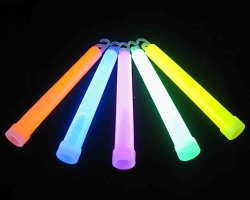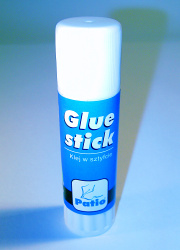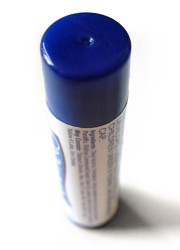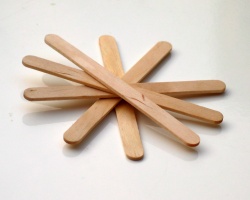How can I reuse or recycle glowsticks / lightsticks?
 Victoria, the ska-core princess who makes fun jewellery out of buttons, wire and the like, has left us a question on our Suggest-An-Item page:
Victoria, the ska-core princess who makes fun jewellery out of buttons, wire and the like, has left us a question on our Suggest-An-Item page:
Any ideas for recycling use glow sticks?
The type you might get at raves and festivals with the non-toxic chemicals that create a reaction when the stick is ’snapped’.
*high five*
*high five* back to you ;)
While there is an obvious potential case for reduction in their use at festivals etc, according to the very detailed Wikipedia article on them, there are a lot of practical uses too because they’re a waterproof light source that doesn’t require electricity or create sparks, so even if every raver gave them up, they’d still be plenty hanging around.
I suspect actually recycling them will be difficult because of the chemical mix but anyone know more about them?
As for reuses, apparently “dyes used in glow sticks usually exhibit fluorescence when exposed to ultraviolet radiation. Therefore even a spent glow stick will shine under a black light” – perhaps they could be used to make art or as guide lines on walls etc in places with UV lighting?
Any other suggestions?
























So far glow sticks manufacturers have not yet provided guidelines on recycling them so there is no standard procedures for recycling glowsticks. As to re-use them, glow sticks are perishable products and are made for one-time use only. Once the chemical reactions are done the chemical contents are consumed and they can’t be re-used.
actually they can be reused i have reused them before
Please provide details Allison. There are those of us that would like to reuse them and don’t know how.
there is a rumour and i don’t know if it works or not that if after the night you put it in the freezer it will do you another night but i don’t know if that works or not.
thats true, because it slows down the chemical reaction so simply its still reacting but very slowly
p.s i have just relised how stupid that sounds.
i was told that when i was younger!!
My friend who works in quality is very wary of glow sticks- the chemicals inside of them are not great.
Her comments are that they are seen as non-toxic because they pass EN 71 testing but that doesn’t actually mean the product is safe it just means the areas they have tested are okay. So example they won’t look at the actual chemicals inside the item they’ll just do EN 71 Part 3 heavy metal testing on the outer parts e.g lead, barium, mercury.
If the glow sticks can pass Bite test of BS5239 then the risk is reduced but it needs to be quite hard plastic to do that. The flimsy ones you see at fairs and festivals won’t passes this and obviously the harder plastic ones that do pass can be opened with a knife/scissors if the person ready want to. The chemicals inside are not nice and with the advent of REACH there is a good chance some of them below will be banned for use in lines like this in the next couple of years
So here is the lowdown:
Glowsticks work because of Chemiluminescience. Its what we call cool light as it is the result of a chemical reaction liberating Photons as opposed to oxidation seen in fire. Its a very usual reaction and as such there are limited chemicals that react in this way.
The glowstick contains two chemicals and a suitable fluorescent dye (sensitizer, or fluorophor). The chemicals in the plastic tube are a mixture of the dye and a derivate of phenyl oxalate ester (also called Cyalume). The chemical inside the glass vial is concentrated hydrogen peroxide. By mixing the peroxide with the phenyl oxalate ester, a chemical reaction takes place; the ester is oxidized, yielding two molecules of phenol and one molecule of peroxyacid ester. The peroxyacid decomposes spontaneously to carbon dioxide, releasing energy that excites the dye, which then deexcites by releasing a photon. The wavelength of the photon—the color of the emitted light—depends on the structure of the dye
The reactions are effected by temperature, so in cold they shine less brightly but last longer, in hotter conditions shine brighter but burn out quicker. There is no way to re energise the samples but they should glow under UV in a similar fashion.
Activator
Hydrogen peroxide
Harmful, Corrosive:- can causes serious burns. Eye contact can cause serious injury, possibly blindness. Harmful by inhalation, ingestion and skin contact
Solvents Used
DiEthylHexylPhthalate (DEHP)
Harmful, Reprotoxin :- may damage the developing fetus and may also damage the testes (male reproductive glands).
DiButyl Phthalate (DBP)
Harmful, Reprotoxin :- may damage the developing fetus and may also damage the testes (male reproductive glands).
Fluorophors used
• 9,10-diphenylanthracene (DPA) emits blue light
Toxicity not fully investigated may be Harmful or Toxic
• 1-chloro-9,10-diphenylanthracene (1-chloro(DPA)) and 2-chloro-9,10-diphenylanthracene (2-chloro(DPA)) emit blue-green light with higher efficiency than unsubstituted DPA, dihydro(DPA) is purple
Toxicity not fully investigated may be Harmful or Toxic
• 9,10-bis(phenylethynyl)anthracene (BPEA) emits green light
Irritant
• 1-chloro-9,10-bis(phenylethynyl)anthracene emits yellow-green light, used in 30-minute high-intensity Cyalume sticks
Irritant, May cause respiratory and digestive tract irritation. The toxicological properties of this material have not been fully investigated.
On ingestion immediately get medical aid
• 2-chloro-9,10-bis(phenylethynyl)anthracene emits green light, used in 12-hour low-intensity Cyalume sticks
Irritant, May cause respiratory and digestive tract irritation. The toxicological properties of this material have not been fully investigated.
On ingestion immediately get medical aid
• 1,8-dichloro-9,10-bis(phenylethynyl)anthracene emits yellow light, used in Cyalume sticks
Irritant, May cause respiratory and digestive tract irritation. The toxicological properties of this material have not been fully investigated.
On ingestion immediately get medical aid
• Rubrene emits orange-red light.
Irritant, May cause respiratory and digestive tract irritation. The toxicological properties of this material have not been fully investigated.
On ingestion immediately get medical aid
• 2,4-di-tert-butylphenyl 1,4,5,8-tetracarboxynaphthalene diamide emits deep red light, together with DPA is used to produce white or hot-pink light, depending on their ratio
Irritant, May cause respiratory and digestive tract irritation. The toxicological properties of this material have not been fully investigated.
On ingestion immediately get medical aid
It worth noting that the phenols produced as a result of the chemical reaction is also toxic
Thank you for your very thought provoking posting, I am afraid I can’t believe in the light of what you have so clearly told us why anyone would consider using microwaves or setting fire to them or even freezing them.
This is actually a project idea I’ve wanted to do for ages, but never got around to it – you know the type of skinny glowsticks that go around your wrist/neck? Try wrapping some pretty string/ribbon in tight loops around it, making sure nothing underneath shows. To finish – little superglue should do the trick. Looks great when you make a few of different/coordinating colours to stack on your wrists :)
Actually, putting the glowstick in the freezer does slow down the reaction. I have done it several times in my childhood. The light isn’t as good as when you first crack it but it does work.
My teenage son wants to light them on fire in the street. I’m not for this, obviously. Any idea what the consequences would be?
You can actually put them in the microwave… But be careful they will be hot and fragile… don’t put them in for anymore then 10 to 15 seconds at a time.
Do at your own risk….
ooh, if you put them in the microwave do thay work again??
You can also stick them in your but , but they will not glow , but you can i not know why , and you do it at your own risk
since its an chemical reaction between to different fluids. you cant reuse the glow stick unless you change the product-fluid to the original chemicals.
if you freeze it when it shines, then you will probably stop the chemical reaction = it stops shining until it gets warmer and the reaction starts again. dont know how cold it needs to be tho.
I wanna know actual IDEAS. Not just repeats of “put em in the freezer blah blah blah…” or “…slows down the reaction…” BECAUSE WE HEARD YOU THE FIRST TIME!!!! I just want more ideas in the comments like
-t. said. In fact she or he is the only one with a recycling idea. Thank you thank you.
The bracelet glow sticks work great to keep all your ponytail holders in one place while storing them
I make really cool bracelets out of used glow sticks. I am planning to sell them in the future. You could also glue them around a jar for a cool effect. I sometimes make shapes and structures out of them. You can do so many cool things to everything. All you need to have is imagination.
You could also donate them to a babysitter for a bracelet craft with kids.